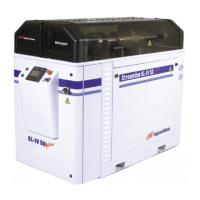SECTION 7
HIGH PRESSURE WATER
p. 7-10
80078868
sandpaper. Sand in rotating motion, avoiding longitudinal motions, which
could cause leaks. Note that grooves or ridges are typically caused by seal
debris buildup rather than by marks in ID wall of HP cylinder.
8. Inspect plunger surface for flaws. Rotate plunger 360- degrees by hand while
viewing light reflection on plunger surface to note any dullness, streaks, pits
or other defects. Run fingernail perpendicular to direction of suspected
surface flaws to gage severity of defects. Depending on seal life achieved
with removed HP plunger seal, make judgment regarding whether to
replace plunger. Refer to Paragraph 7.2.6 for procedure regarding plunger
removal/ installation.
Seal Installation Procedure
1. Lightly coat seal components with FML grease refer to Table 7-2 item 1 prior
to installing seal parts on plunger. Install new HP plunger seal assembly onto
plunger, refer to Figure 7-2, Detail I, for proper seal component orientation.
Note that steel spring inside U-cup (if so equipped) can be easily distorted.
Verify that U-cup spring, lips and cavity appear uniform prior to installation.
NOTE: Bronze packing follower is intended to fit tightly on plunger. If follower is
too tight to slip onto plunger, try heating follower in hot water. Then
attempt to slip follower over plunger.
2. Slip plastic cylinder liner tube over plunger.
3. Install HP cylinder jug to hydraulic cylinder head per paragraph 7.2.2.

